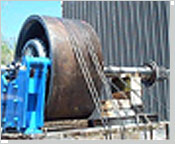 It's the production process under which high pressure deforms plastically metal into high strength components. It is also called hot heading process. Using this process cross-sectional size of a bar can be increased, either at ends or at some point along the length. Specially designed upsetting machines using closed dies are used to control size and shape. They can be made in various sizes. The mechanical press producing these components operates horizontally. The dies are split up allowing material to reach beyond the mechanical press. The forming force is supplied by a third die attached to the header. The process when done cold is called Cold Heading.
It's the production process under which high pressure deforms plastically metal into high strength components. It is also called hot heading process. Using this process cross-sectional size of a bar can be increased, either at ends or at some point along the length. Specially designed upsetting machines using closed dies are used to control size and shape. They can be made in various sizes. The mechanical press producing these components operates horizontally. The dies are split up allowing material to reach beyond the mechanical press. The forming force is supplied by a third die attached to the header. The process when done cold is called Cold Heading.
- Greater Strength:As the material grain flow is oriented to the component's shape, compared to parts machined from bar stock, upset forgings offer greater strength.
- Piercing and Trimming Operations:This contribute towards component weight reduction and eliminate machining operations.
- Economical Production:As Upset forgings require fewer operations, have lower scrap costs, that can result in more cost efficient production
Application of Upset Forgings:
Artillery shells, cluster gear blanks, heads of bolts, valves, single and cylinders for radial engines are examples of parts made by upset forging.
